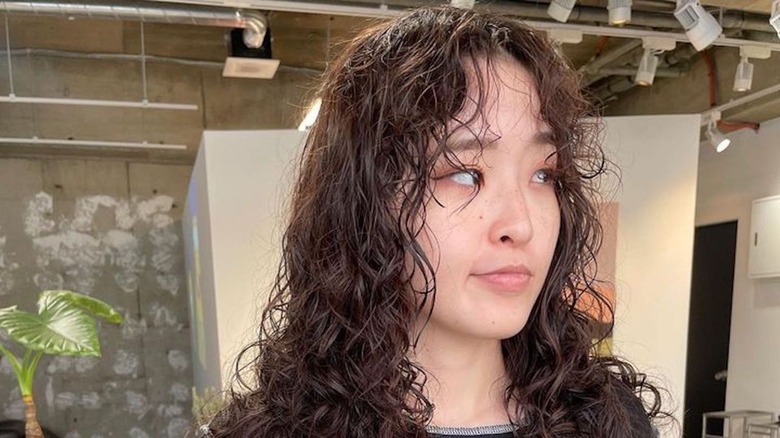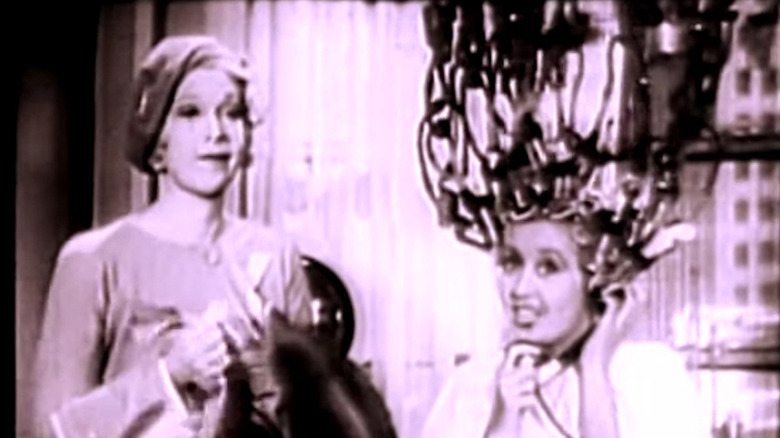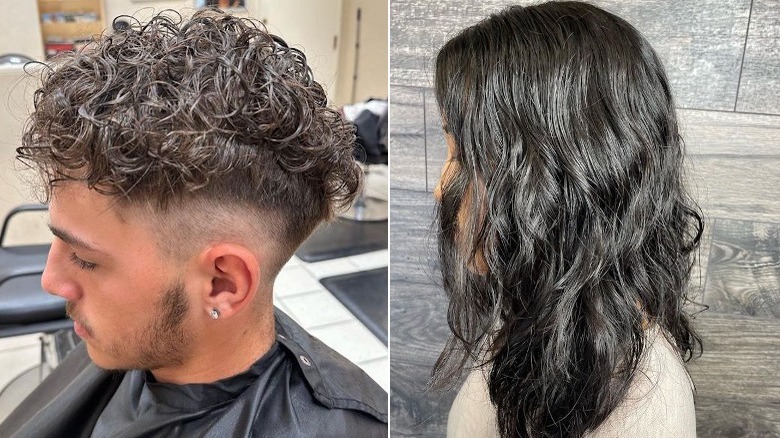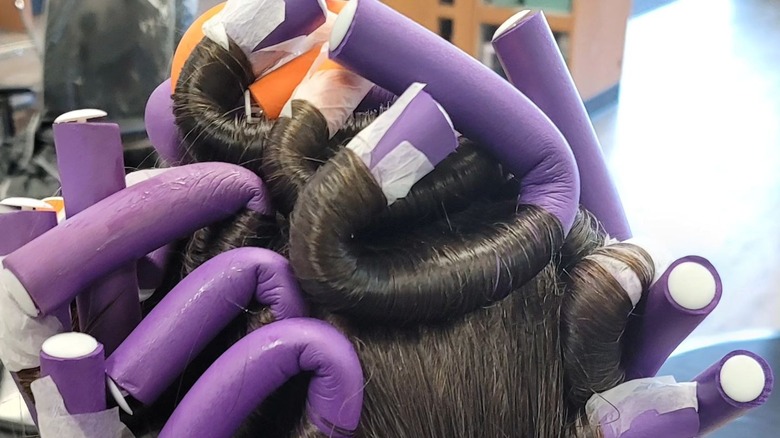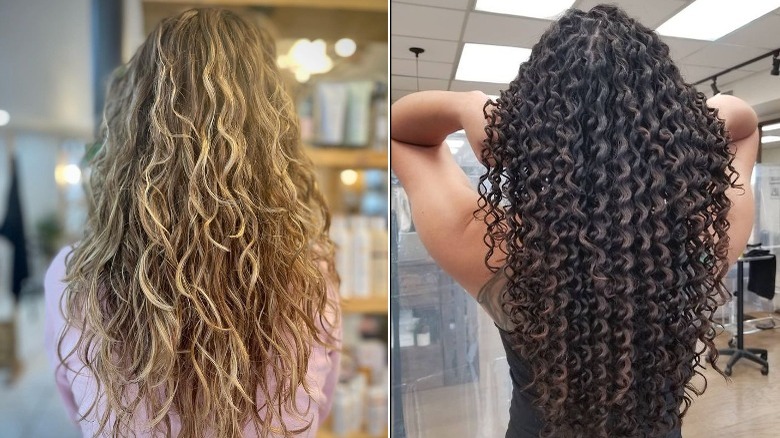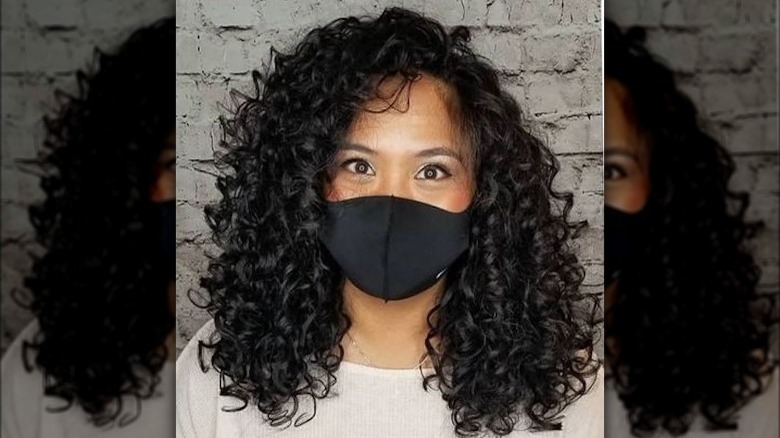It's About Time We Stop Treating Perm Like A Dirty Word - There's More To It Than Meets The Eye
The idea of permed hair often conjures up specific, somewhat terrifying images of curly hair problems: like Bradley Cooper in "American Hustle" or Little Orphan Annie, the fictional character with bright red hair and extremely tight curls. Even the wide, poofy hair of Chutney Windham, the villain Elle Woods outed in "Legally Blonde," is something to run from today.
But perms have come a long way since the 1980s. They're no longer the hair-killing, sizzled and fried techniques they used to be, resulting in overprocessed, tight curls — and they're making a comeback. The old-style perms used heat without protectant, and harsh chemicals to curl the hair, such as ammonia and ammonium thioglycolate, as Elle Woods pointed out, resulting in often brittle curls and frizz.
Fortunately, today's perms no longer use such harsh, damaging chemicals, and many are ammonia-free instead. The technology has changed so that today's permed hair is silky and soft, not brittle, staying with the beauty industry's recent shift toward natural looks and an "I woke up like this" mentality. The modern perm can add texture and volume to hair through soft, wavy curls. "Perm provides a base for you to control your style, so your hair has more volume and body — it gives movement and a lived-in feel," hairstylist Guy Tang, who gets perms himself, told Refinery29. "I am personally addicted and cannot live without the perm. It gives me confidence, and it can do the same for you." Let's reconsider the modern perm.
A brief history of the perm
While we often think of the 1980s when we think perms, the popular hairstyle actually dates to the late 19th century. Marcel Grateau first devised a method for curling hair using heat with specially manufactured tongs in the early 1870s. In 1905, Karl Nessler (Charles Nestle professionally) created a new process for curling hair, reconfiguring the cell structure of hair using borax paste, then clamping it in sections in his wave machine, a chandelier-looking torture device that turned every woman into Medusa for a while. As they sat with curlers that weighed three to four pounds each(!), heat (first powered by gas, later by electricity) made the hair curly.
Fortunately, the system became a lot simpler in later years, first when African American hairdresser Marjorie Joyner patented a dome-shaped heating helmet for salon patrons. Then Zotos Professional invented the machineless permanent wave in 1929, and Arnold F. Willat created the "cold wave" perm, using thioglycolic acid instead of heat, in 1938, which is closer to what we now know as the modern perm. With the Acid Perms of the 1970s, which sound horrible but are actually gentler, perms became much more popular.
Now, nearly 100 years later, Zotos Professional is responsible for the 1980s hairstyles on the hit Netflix series "Stranger Things," which is a big reason for the current resurgence in perms as a trend. Nostalgia is a powerful drug and "Stranger Things" is definitely helping the '80s make a comeback. And perms are genderless, so anyone can get one.
What are the different types of perms?
Generally speaking, a perm is a process for chemically altering the hair follicle in a "permanent" way, which lasts until the new, untreated hair grows in. While it frequently refers to adding curl or wave to straight hair, it can also straighten naturally curly hair. The methods for applying perms vary: Acid or hot perms use an acidic chemical process and heat, while alkaline or cold perms use a different chemical solution to form curls without heat. The digital process features a modernized perm machine with a digital display, while organic perms use natural oils.
Within those application processes, there are at least four styles of perm. In a spiral perm, the hair is wrapped vertically around hot rods to create tight, corkscrew curls. This often results in shortening the overall length of the hair, so be careful with this style if your hair is already short. The body wave uses a wider rod to create looser S-waves, adding volume and movement to your hair. An easy entry into the perm life is the beach wave perm, a lighter process using foam flexirods resulting in long spirals of easygoing curls that look natural and are easy to maintain. If your hair has a range of types and textures, consider a spot or partial perm. Your hairdresser will use different-sized rods to match your new curls to your natural texture, giving more volume. There are other options as well, which can be chosen and tailored to suit your hair type and thickness.
What exactly is the perm process?
If you're ready to ride that wave, expect to spend some quality time in the salon chair. The perm process can take a few hours, and the price ranges from $30 to $800, depending on hair length, health, style, and process. Talk to your stylist about the kinds of curls you want, so they can decide what rods to use (and pictures help). Smaller rods create tighter spirals, while bigger rods produce looser S-waves. Your stylist could even use a combination of sizes depending on the style you want.
Some stylists use treatments to "detox" the hair of harmful ingredients before starting the perm treatment, so that the hair will react better to the perm solution. Once the hair is healthy and clean, a stylist might use a protein treatment to maintain its health, so that the hair is strong enough to withstand the perm process.
Once your hair is ready for the chemical alteration, it will be wrapped in rods and doused with perm solution, which will be left on your head for 20 to 30 minutes, depending on your hair type. There are kinder, gentler solutions available today, many of which are ammonia free. Then the stylist uses a neutralizer on the hair, while it's still in rods, to lock your hair into its new shape and reform the bonds between the protein molecules. Then they'll rinse your hair, remove the rods, and begin styling, just like their curly-haired clients.
How long do perms last?
While even fine hair can hold a body wave perm, you don't have to have straight hair to get one. A perm can make naturally curly hair consistent and add volume. If you find yourself using curling irons, a perm can save time and money in the long run. However, if you already use chemical straighteners or lighteners in your hair, you might want to wait. "Even though perms are less damaging now, they still are damaging because you are changing the structure of your hair," celebrity colorist Rita Hazan told Refinery29. Always consult with your hairstylist about what they recommend.
Despite the name, perms aren't permanent for long, since hair continues to grow and change. Permed hair requires different treatment to style and maintain than natural hair. Just as Elle Woods taught us, keep your hair dry for 48 hours after the process, and wash infrequently. Use a wide-tooth comb instead of a hairbrush, and a diffuser instead of blow-dryer, for daily upkeep. Use protective moisturizing products that maintain your curl and consider at-home protein treatments. Shorter hair will probably need more frequent touchups than long hair, and consider a restructuring cut to maintain the structure and body of your hair. But a good perm can last 3 months to a year, depending on your hair and lifestyle.
Perms from curly to straight
Remember that a curly perm means you're committing to this look, at least for a while. "If you want to revert back to straight hair," specialist Mallory Granrath told Refinery29, "I recommend letting it grow out or committing to a short cut if you want to keep your hair healthy." But perms can help with straightening naturally curly hair too.
A keratin treatment or Brazilian blowout generally starts at $150 and can take a few salon appointments to complete. Japanese thermal straightening costs more and takes longer to complete, but presumably lasts longer. Be careful of relaxers and straighteners that contain formaldehyde, and look instead for lye-free or alkaline sulfite-based straighteners. Remember too that all perms (straight or curly) use chemicals that cause damage and contain odor, so natural hair is always an option.
Whatever you decide, find a way to love your hair (and yourself), whatever the texture. Avoid pressure to straighten or curl your hair to meet some societally-imposed (often Eurocentric) standard of beauty. As beauty trends lean toward natural hair, embrace what you have, and forget any stigmas against either keeping it natural, or changing it to something that you love. "No one tells white girls with straight hair they are a traitor for using a curling iron or curlers to make their hair curly," one Redditor said on a thread about experimenting with mixed-race hair. "Do you. As long as you take care of it, you should be able to wear your hair however you want."
